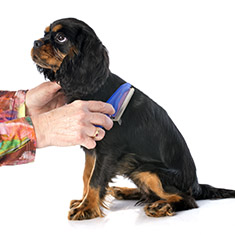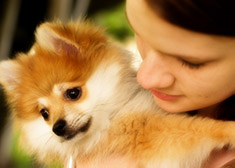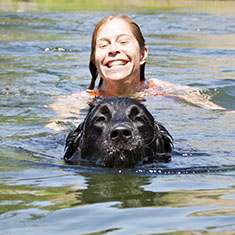Bonding With Your New Puppy
When you give birth to a two-legger, much importance is given to the value of bonding with your new child. Did you ever think about how valuable it might be to your puppy if you bonded with him or her?

The importance of bonding
Although dogs are often called “man’s best friend”, ideally your dog will be a better friend to you than to the other people in the neighborhood. You can accomplish this if you take the time necessary to properly bond with your dog when you first bring him or her into your home.
Bonding allows your dog to develop a special link to you and your family such that the dog will do anything you ask him or her to. This is especially important if you will be using the dog as a guard or if you will be participating in obedience trials. However, every dog will benefit from close bonding with one or more humans.
As pack animals, dogs require social interaction. While it’s true that you want to quickly establish your place as the alpha dog in the pack, you will also want your dog to know that he or she is a valued member of the social structure. This can prevent many behavioral problems later in life. Dogs who know they are valued are less likely to suffer from separation anxiety and less likely to destroy your home when they get bored. They may also bark less and are less likely to be overly-aggressive.
How is bonding accomplished?
The most important factor in how well you and your dog will bond is time. Quite simply, the more time you spend with your puppy, the better and stronger the bond that the two of you will forge. The other requisite for a tight bond is that you use positive methods to work with your dog so he or she will want to form a special connection with you.
Beyond those two items, how you bond with your puppy is entirely up to you. You will likely use a number of different activities to promote bonding, ranging from grooming to taking walks to playing games to training. Even just taking your dog with you when you run errands can help to strengthen the bond you share, even while providing important socialization opportunities.
Bonding with your puppy through grooming

Grooming your dog provides a great opportunity for bond formation. Make sure to use tools that won’t scare your dog to keep the experience positive. For example, if your dog has long, curly hair, you probably don’t want to groom with a brush that pulls the hair rather than smoothing it. If your dog doesn’t do well with noise, a toenail grinder might not be the best way to trim his or her nails.
Assuming you are bringing home a young puppy who has had no prior bad experiences with another guardian, you should be able to easily get your dog used to the grooming techniques you will be using throughout his or her life. Each time you introduce a new grooming tool, give your dog time to sniff at it and get used to whatever noises it might make.
For example, if you will be using a hair dryer after baths, let your dog smell the dryer before you turn it on. Next, place the dryer a few feet away from the puppy and turn it on, letting the puppy go to the dryer to check it out, rather than bringing the dryer closer to the dog. Only after your puppy is used to the sound should you try to actually use it to dry him or her.
Bonding with your puppy through walking
Another great way to bond with your puppy is through walks. Obviously, new puppies need plenty of walking, so you will have lots of opportunities. Spend some time each day getting your new dog used to his or her leash and collar before you begin taking walks. Put a collar on your dog for short periods of time, rewarding the dog with play and praise each time he or she leaves it alone for a few minutes rather than scratching the dickens out of it. Let the dog drag the leash around your living room for awhile before you attempt to pick it up and lead him or her.
Stay close by your dog as you go through these activities to reassure the animal that you won’t let anything hurt him or her. Your puppy will bond closely to you when he or she realizes that you are a safety net against all things terrifying.
Bonding with your puppy through play time
Puppies have an uncontrollable urge to play, and you should make sure you are a part of play time. Bonding requires that your puppy learn to depend on you to provide the games, toys, and interaction that make play so desirable. Play serves another important purpose: figuring out what drives your dog so you can use it to your advantage when you begin obedience training.
It’s not too hard to figure out what drives your puppy. Simply present him or her with several choices and see which one draws the most attention. For example, you might set down a bone, a squeaky toy, and a tug toy. Bring your dog into the room and let him or her sniff each toy. It won’t be long before he or she picks one of them to play with. Whichever one he or she picks will be your reward toy to use as you work on deepening your bond by providing positive rewards.

Regardless of which toy your puppy chooses first, he or she will likely want to play with all of them eventually. Spend some time playing with your dog each day. Get down on his or her level and just be silly. Your dog needs to know that it’s not all seriousness, all the time. Your willingness to participate in unstructured, all-out goofiness with your puppy will help the dog attach to you very quickly.
Bonding with your puppy through training
As your puppy begins to get a little older, you will likely want to start obedience lessons. This gives you an opportunity to continue your play sessions, but now they will be a reward for a job well done.
Young dogs have notoriously short attention spans, so be sure to keep your training sessions short. You can repeat the lessons several times throughout the day, and each training session should be followed by a play session. When your dog obeys a training command, make sure to praise the dog lavishly and give a meaningful reward such as a small treat or a few minutes of play time with a favorite toy. Then, at the end of the entire training session, allow the dog to play with you without the requirement of performing a skill first.
The entire training session should be based on play, letting your dog know that following your commands results in a rocking good time. Negative training methods such as spanking, using a rolled-up newspaper, or yelling at the dog will cause most dogs to rebel, greatly extending the length of time required for training.
No matter which of these opportunities you use to develop a bond with your new puppy – more likely you will use several of them – make sure you take the time to enjoy your dog and make him or her the center of your life during those important formative months. It will pay great dividends as your dog grows and develops into a wonderful companion for you.
For more information on bonding with your puppy, check out the articles on Pet Place and Veterinary Partner. You might also be interested in our article on the benefits of dog massage.
Doggies Den: Latest Articles
 Homemade Thanksgiving Treats for Your Dog
Homemade Thanksgiving Treats for Your Dog
NUTRITION We all want to include our dogs in our holiday celebrations, but hopefully, you're aware that sharing table scraps with your dog isn't always the best idea.
 Keeping Your Dog Safe during the Summer Months
Keeping Your Dog Safe during the Summer Months
HEALTH Summer is coming on fast, so it’s time to plan how you will keep your dog safe and healthy through the lazy, carefree, warm days.
 Vaccination Time Again-Keeping Your Puppy Healthy
Vaccination Time Again-Keeping Your Puppy Healthy
DOG HEALTH So you have your new puppy picked out. There are quite a few shots, treatments and examinations that will keep the newest member of your family healthy.
 Canine Thanksgiving Feast
Canine Thanksgiving Feast
NUTRITION With the wide variety of food at Thanksgiving dinner, chances are you'll want to give your dog something special, too. If you're contemplating what to feed your dog for the holiday, here is a guide to a great Canine Thanksgiving Feast.
 Dog Walking Tips Every Owner Should Know
Dog Walking Tips Every Owner Should Know
DOG FUN Walking your dog is not only crucial to keeping him healthy and happy, it strengthens the bond between your canine friend and his caregiver. There are a lot of obstacles out there. Don’t forget these simple tips to keep your walk fun and safe in the outside world.
 The Benefits of Physiotherapy for your Dog
The Benefits of Physiotherapy for your Dog
HEALTH The same techniques that physiotherapists use to treat a variety of injuries and conditions in humans have been adapted to suit animals with great success. Family pets, show dogs, and working dogs can all benefit greatly from physiotherapy. Dogs whose activities involve a lot of agility are especially susceptible to the types of problems that physiotherapy can address.
 The Decision- Adding a Dog to Your Family
The Decision- Adding a Dog to Your Family
FIRST TIME OWNERSBringing a dog into your family is a decision where many people don’t realize it’s magnitude until after they have the dog. There are a number of things that you need to research before you decide to purchase a dog, and it starts right in your own home.
 Bringing Your Dog Into Your New Baby's Life
Bringing Your Dog Into Your New Baby's Life
HEALTH Many believe that a dog and a new baby cannot happily coexist, so therefore the dog has to go. This is not necessarily the case.  A new baby does not mean you have to abandon your dog.

Doggies Den:
Most Popular Articles

Dog Pregnancy Symptoms
HEALTHIf you suspect your dog might be pregnant, check out part one in this series on pregnant dogs, where we cover pregnant dog symptoms.

Dog Birth
HEALTHIn the third article of our dog pregnancy series, we look at the wonderful, but messy, process of bringing newborn puppies into the world.

Indoor Dog Potties
DOG PRODUCTSIt's been a long day at work. You were so busy, you didn't even take time to eat a sandwich, let alone run home to let your dog out. You're on your way home, knowing the poor dog is crossing his or her legs by now, when your car breaks down, delaying you even further. Can't somebody make this easier?

Your Dog’s Digestive System
PHYSIOLOGYEver wonder why your dog eats so fast? Or why he eats gross things? Or why he gets sick to his stomach? Or why his waste stinks so bad? Some of these things are normal, some are not.

Canine Respiratory System
BREATHINGThe basic function of your dog's respiratory system is to bring oxygen in to and remove carbon dioxide from the body. Knowing the symptoms of respiratory diseases can help you help your stay healthy.

Shelter Dog Adoption Tips for Success
ADOPTION Are you intimidated by the prospect of "rescuing" a dog from a shelter? One reason that you may be wary of adopting a dog from a shelter is not knowing how to choose. Adopting a dog from a shelter can be a rewarding process, if you're prepared to do a reasonable amount of research.

Canine Urinary Tract Infections
SYMPTOMS AND TREATMENTDoes your dog seem to be having trouble relieving his or her bladder? Learn how to recognize the signs of urinary tract infections and how to treat them before they spread.

What to do for Dog Diarrhea
SYMPTOMS AND REMEDIESIf you have dogs in your house for any length of time, you have likely experienced at least one bout of dog diarrhea. Beyond the pain in the tuckus involved in cleaning up the mess, you should know what causes diarrhea, and when it's important to see the vet.

What to do for a Dog Bite
DOG BEHAVIOR Getting bitten by a dog can be scary, and you may be tempted to run around in circles for a while, trying to figure out what to do. Here's our guide to help you manage the situation.

Top Ten Tips for Living with a Senior Dog
DOG HEALTH Bringing home a new puppy is so exciting, but it doesn’t take all that long for your exuberant puppy to grow into a senior dog who may have special needs. Here are the doggies.com top ten tips for taking care of your companion who has been with you through so much.
